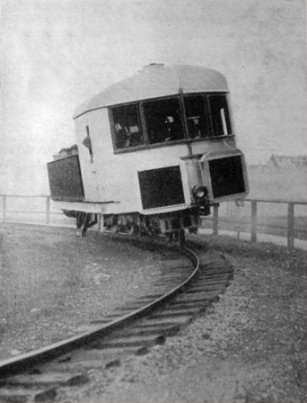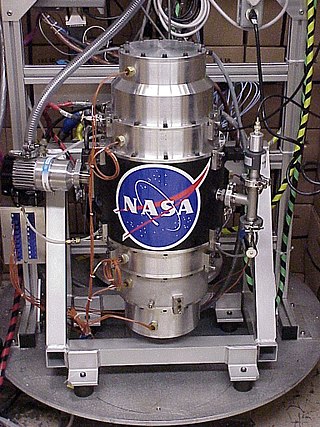Related Research Articles

A bicycle, also called a pedal cycle, bike, push-bike or cycle, is a human-powered or motor-assisted, pedal-driven, single-track vehicle, with two wheels attached to a frame, one behind the other. A bicycle rider is called a cyclist, or bicyclist.

A Segway is a two-wheeled, self-balancing personal transporter device invented by Dean Kamen. It is a registered trademark of Segway Inc. It was brought to market in 2001 as the Segway HT, and then subsequently as the Segway PT.HT is an initialism for "human transporter" and PT for "personal transporter."

A gyroscope is a device used for measuring or maintaining orientation and angular velocity. It is a spinning wheel or disc in which the axis of rotation is free to assume any orientation by itself. When rotating, the orientation of this axis is unaffected by tilting or rotation of the mounting, according to the conservation of angular momentum.

An electric unicycle is a self-balancing personal transporter with a single wheel. The rider controls speed by leaning forwards or backwards, and steers by twisting or tilting the unit side to side. The self-balancing mechanism uses accelerometers and gyroscopes. Most manufacturers of EUCs are based out of China, including Segway, Inmotion, Kingsong, Begode, and Leaperkim.

Elmer Ambrose Sperry Sr. was an American inventor and entrepreneur, most famous for construction, two years after Hermann Anschütz-Kaempfe, of the gyrocompass and as founder of the Sperry Gyroscope Company. He was known as the "father of modern navigation technology".

A gyrocar is a two-wheeled automobile. The difference between a bicycle or motorcycle and a gyrocar is that in a bike, dynamic balance is provided by the rider, and in some cases by the geometry and mass distribution of the bike itself, and the gyroscopic effects from the wheels. Steering a motorcycle is done by precessing the front wheel. In a gyrocar, balance was provided by one or more gyroscopes, and in one example, connected to two pendulums by a rack and pinion.

Vehicles that have two wheels and require balancing by the rider date back to the early 19th century. The first means of transport making use of two wheels arranged consecutively, and thus the archetype of the bicycle, was the German draisine dating back to 1817. The term bicycle was coined in France in the 1860s, and the descriptive title "penny farthing", used to describe an "ordinary bicycle", is a 19th-century term.

Countersteering is used by single-track vehicle operators, such as cyclists and motorcyclists, to initiate a turn toward a given direction by momentarily steering counter to the desired direction. To negotiate a turn successfully, the combined center of mass of the rider and the single-track vehicle must first be leaned in the direction of the turn, and steering briefly in the opposite direction causes that lean. The rider's action of countersteering is sometimes referred to as "giving a steering command".

A monowheel or uniwheel is a type of one-wheeled, single-track vehicle. Unlike the unicycle, a monowheel consists of a large, hollow wheel that loops above and around the driver. Monowheels are typically powered by an engine as with a motorcycle, with a chassis securing the steering, driver's seat, and propulsion mechanism to the interior of the wheel.

Ship stabilizers are fins or rotors mounted beneath the waterline and emerging laterally from the hull to reduce a ship's roll due to wind or waves. Active fins are controlled by a gyroscopic control system. When the gyroscope senses the ship roll, it changes the fins' angle of attack so that the forward motion of the ship exerts force to counteract the roll. Fixed fins and bilge keels do not move; they reduce roll by hydrodynamic drag exerted when the ship rolls. Stabilizers are mostly used on ocean-going ships.

The gyro monorail, gyroscopic monorail, gyro-stabilized monorail, or gyrocar are terms for a single rail land vehicle that uses the gyroscopic action of a spinning wheel to overcome the inherent instability of balancing on top of a single rail.

Bicycle and motorcycle dynamics is the science of the motion of bicycles and motorcycles and their components, due to the forces acting on them. Dynamics falls under a branch of physics known as classical mechanics. Bike motions of interest include balancing, steering, braking, accelerating, suspension activation, and vibration. The study of these motions began in the late 19th century and continues today.

Ship stabilizing gyroscopes are a technology developed in the 19th century and early 20th century and used to stabilize roll motions in ocean-going ships. It lost favor in this application to hydrodynamic roll stabilizer fins because of reduced cost and weight. However, since the 1990s, there is renewed interest in the device for low-speed roll stabilization of vessels. Unlike traditional fins, the gyroscope does not rely on the forward speed of the ship to generate a roll stabilizing moment and therefore can stabilize motor yachts while at anchor. However, the latest generation of "zero speed" fins stabilizers can stabilize yachts while at anchor thanks to their eccentricity with respect of the shaft.

Spin-stabilized magnetic levitation is a phenomenon of magnetic levitation whereby a spinning magnet or array of magnets is levitated via magnetic forces above another magnet or array of magnets, and stabilised by gyroscopic effect due to a spin rate that is neither too fast, nor too slow to allow for a necessary precession.

The Uno is a novel self-balancing electric motorcycle using two wheels side by side. The Uno III adds a third wheel that allows it to transform into a tricycle.

Flywheel energy storage (FES) works by accelerating a rotor (flywheel) to a very high speed and maintaining the energy in the system as rotational energy. When energy is extracted from the system, the flywheel's rotational speed is reduced as a consequence of the principle of conservation of energy; adding energy to the system correspondingly results in an increase in the speed of the flywheel.

Kickstarter, PBC is an American public benefit corporation based in Brooklyn, New York, that maintains a global crowdfunding platform focused on creativity. The company's stated mission is to "help bring creative projects to life". As of February 2023, Kickstarter has received US$7 billion in pledges from 21.7 million backers to fund 233,626 projects, such as films, music, stage shows, comics, journalism, video games, board games, technology, publishing, and food-related projects.
Lit Motors Inc. is a San Francisco-based company that designed conceptual two-wheeled vehicles, including a fully electric, gyroscopically stabilized vehicle.

Daniel Wood is an American inventor and entrepreneur, best known for creating the first commercially available self-balancing unicycle. He is currently the founder and CEO of Focus Designs. He is also the Director of Control Systems at Future Motion as well as an advisory council member at RYNO Motors.

Shane Chen is a Chinese-American inventor and entrepreneur based in Camas, WA USA. He is best known for inventing the self-balancing hoverboard.
References
- ↑ "Reason for the name change". Jyrobike. Retrieved 2014-03-13.
- ↑ Paul Ridden (August 22, 2012). "Gyrobike training system heads to Europe". GizMag. Retrieved 2014-03-13.
- ↑ "The Bicycle Wheel as a Gyroscope". R Nave, Georgia State University. Retrieved 2014-03-13.
- ↑ "An Introduction to Bike Geometry and Handling". Megulon Five at dclxvi.org. Retrieved 2014-03-13.
- ↑ "SLIDESHOW: Photos from the 2006 Breakthrough Awards". Popular Mechanics. Retrieved 2014-03-13.
- ↑ "Reinventing the wheel". Tuck School of Business. Retrieved 2014-03-13.
- ↑ "GYRO BIKE & GYRO WHEEL – THE BEST TRAINING WHEEL". Move Mee. Retrieved 2014-03-13.
- ↑ "Gallery: Best of Toy Fair 2010". Pop Science. Retrieved 2014-03-13.
- ↑ "System for providing gyroscopic stabilization to a two-wheeled vehicle". Google. Retrieved 2014-03-13.
- ↑ Samantha Hurst (February 13, 2015). "Jyrobike Leaves Supporters in Limbo; Project Goes Dark with $185,0000 from Crowdfunding". Crowdfund Insider. Retrieved 2019-07-16.
- ↑ Team Jyrobike (November 25, 2014). "Jyrobike - Auto Balance Bicycle". Kickstarter.com. Retrieved 2019-07-16.
- ↑ "This domain jyrobike.com may be for sale. Click here for more details" . Retrieved 2019-07-16.